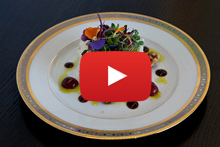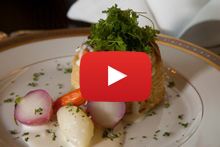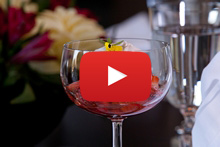
Recipes from Chef Joao Marcos Barboza - SWITZERLAND
Christophe Avril of Diplomatic Connections with Swiss Residence Chef Joao Marcos Barboza
Picture a warm and cozy little chalet in Switzerland, the table is set; a long wooden table, not far from the fireplace with a classic and skillfully handcrafted red and white table cloth. The light in the room has a soft yellow tone, which is accentuated by the wood walls of the chalet. The warm atmosphere is contrasting with the cold winter weather. It is dinner time. Salami and Viande des Grison are waiting on a plate. A Pinot noir or a Chasselas are served in a glass. The hazelnut ginger bread is diffusing its aroma next to a delicious soft loaf called Zopf. A cheese and onion tart tries to compete with a Zürcher Geschnetzeltes (veal liver and mushrooms, served with a cream sauce and Rösti). There is an abundance of cheeses, such as Appenzeller, Vacherin fribourgeois, Tilsiter, Emmental, and Gruyère. A few pastries lay about, in case you are still hungry. Bündnernusstorte (caramelized nut-filled pastry), an Aargauer Ruebli Torte (traditional Swiss carrot cake), and Swiss Cinnamon Crisps to accompany your coffee. And to finish, a Gentian schnapps or Kirsch served in a small glass. These are strong digestives, but trust me, after a typical Swiss meal, you will need it.
The Suisse Cuisine was in many ways influenced by its neighbors. Switzerland shares borders with France, Germany, Austria, Liechtenstein, and Italy. Four languages are spoken: French, German, Italian, and Romansh. Since 70% of the country consists of mountains, the winter is cold and long. This might explain why the country’s culinary tradition has a tendency to be invigorating and calorific. With 26 Canton, or counties, each part of the confederation has a different specialty to offer.
Switzerland is by far not the biggest country in Europe. It has a population a little over 8 million spread over an area of 15938.30 mi (41280 km). But with more than 800 cheeses, a large variety of salami and sausage, dried meats, pastries, 240 different grape varieties and, of course, its world famous chocolate, its culinary variety makes up for its size.
Among the most renown Swiss specialties we have the cheese Fondue, the Raclette, the Älplermagronen, the Rösti, and the milk Chocolate. The latter was invented by Daniel Peter in the year 1875 and perfected in 1879 by Rudolf Lindt with the development of the conching machine, which facilitated the mixing of cacao butter with chocolate. His name remains famous in the chocolate industry. Other familiar brands are also well-known worldwide: Kohler, Suchard, Cailler, and Tobler.
The Swiss cuisine has a long and impressive history, and who better than the Swiss Ambassador in Washington, D.C. to tell us about it. Dr. Martin Dahinden earned a Ph.D. in Economics and he is not only a well-known and respected diplomat, he is also a fine gastronome and a history savant. So he combined his two passions and wrote a book, “Schweizer Küchengeheimnisse” or “Swiss Kitchen Secrets.” This book will tell you the history behind the traditional plates in great detail and with compelling passion. You will learn that Napoleon had a Swiss chef during his campaign. You will also know why and how the Kappel milk soup became a diplomatic symbol for peace.
Music, art and literature are the representation of a country, of its people. The Cuisine is also a big part of it. This is why an Embassy, a consulate or a mission to the UN will put a lot of importance and effort in promoting is own cuisine. And for that, the Swiss Embassy has a secret weapon: Chef Joao Marcos Barboza.
Chef Marcos Barboza is from Brazil, not Switzerland, but he has great expertise in international cuisine. His family came from Italy and as a kid being involved in his parents' and grandparents’ kitchen was at the top of the list of favorite activities. Fast forward several years and the esteemed “L'Academie de Cuisine” in Gaithersburg, Maryland was a place he called home for a time; thereafter, moving on to attend the highly regarded “Hotel School of Sant Pol de Mar” in Barcelona, Spain to learn about the robust savory tastes of Mediterranean flavors. His studies then led him to Paris at “Le Cordon Bleu Culinary Arts and Hospitality Management Institute” where it was a prerequisite to be properly educated on the discerning appetites of the French regional population. Continuing his coveted culinary world tour, it was time to perfect his skills and knowledge on the Tuscan Palate, so he went to the “The Apicius Culinary Institute of Florence" in Italy. After mastering European Cuisine, expanding his food repertoire to include an authentic Chinese cooking style as well as Dim Sum making was essential to add to a growing global resume of gastronomy; thus, “Chopsticks Cooking Centre” in Kowloon, Hong Kong, China was the next delicious destination. Southeast Asia was an absolute must with their saporous seasonings and spices, the Chef entered into the “Saigon Cooking Class” in Ho Chi Minh City, Vietnam to be schooled in traditional Vietnamese tasteful techniques that lead to mouthwatering menus. Taking an extra excursion to Bangkok, Thailand, enrolling as a student into the “Art of preparing fine Thai Cuisine” at the Baipai Thai Cooking School was categorically on the itinerary. Completing his intercontinental enterprising expedition learning how to make every day meals leaving people feeling as if they actually visited each respective country, is what seems to most of us an insurmountable accomplishment, but for Chef Marcos, it's just another day in the kitchen.
Chef Marcos worked in the catering business for various embassies such as the Embassy of Finland, Denmark, Sweden, and Australia. A Brazilian restaurant in Washington, D.C. was lucky enough to call him their own official chef for two years. Afterwards, he was then the assistant to the renowned chef, Jeffrey Buden. The political arena in Washington has been a friend to Chef Marcos in catering many exclusive, prestigious events and, by my estimation, has legitimate bragging rights in this community. If all of the above achievements were not enough, Chef Marcos then worked for 8 years at the Residence of the European Union Ambassador to the United States in Washington, D.C. Since November 2014 and currently, he is the chef at the Residence of the Swiss Ambassador in Washington, D.C.
Chef Marcos gave us a menu and its recipes for 4 people. To start, a Waldorf salad that was originally created by Oscar Tschirky, who was the maître d’hôtel more than 60 years ago in the main restaurant of the Waldorf-Astoria Hotel in Manhattan, New York. Then, Vol-Au-Vent à la Béchamel from the Chef Joseph Favre, who was known for his four-volume Dictionnaire universel de cuisine pratique, published in 1903. And to finish, Fraises à la Ritz recipe created by the Swiss “king of hoteliers, and hotelier to kings,” César Ritz; incidentally, it is said that the coined term “ritzy” has its origins in his last name. Chef Marcos has transformed these traditional recipes into modern dishes, but he always respects the original recipes by using all the original ingredients. You can see a video of Chef Marcos on how to prepare these delicious plates by going to our website, www.DiplomaticConnections.com. You can also get the full recipes by downloading the PDF files.
Enjoy, and bon appétit!
 Waldorf Salad |
 Vol au Vent à la Béchamel |
 Fraises à la Ritz |
Download Recipes |
- Apartments, Housing, and Real Estate
- Automotive Sales & Leasing - Cars, SUVs & Trucks
- Clothing & Apparel
- Communications & Technology
- Concierge Services
- Contracting
- Dining & Entertainment
- Education
- Event Planning Services
- Financial Services
- Health & Beauty
- Home Furnishings
- Hotels & Accommodations
- Insurance
- Medical & Dental Services
- Office Services
- Property Management
- Security Services
- Shipping & Moving Services
- Specialty Services
- Travel & Transportation









